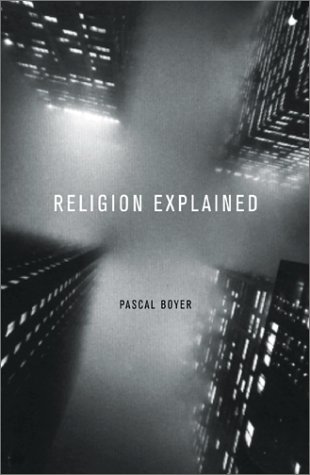 Thunder, earthquakes, droughts, a good harvest, the movements of the sun, moon, planets — we know that ancient people had hosts of myths to explain how all of these things “worked”. It is easy to assume that religious ideas were developed out of primitive attempts to explain these sorts of natural phenomena.
Thunder, earthquakes, droughts, a good harvest, the movements of the sun, moon, planets — we know that ancient people had hosts of myths to explain how all of these things “worked”. It is easy to assume that religious ideas were developed out of primitive attempts to explain these sorts of natural phenomena.
Then there are dreams, and feelings that our beloved deceased are somehow still with us, hallucinations, “bad vibes” . . . These surely puzzled our pre-scientific ancestors. Was it a need to understand these mental phenomena that led to a belief in spirits as an explanation?
Where did everything ultimately come from? Musical instruments? Metal working? Mountains? The sky? Did religion arise by deciding a God or ancestral hero was “the first cause” of all these things?
What about illness? Premature death? A flood sweeping one’s village away? Surely it is only “natural” to want to understand why evil, why suffering. Was religion developed as an explanation for these calamities? Did religion create the ideas of devils, fate, God, to explain all of this?
Pascal Boyer argues that there is something wrong with the above assumptions that religions arose to explain the mysteries of the world and life. He writes:
Now anthropologists have shown that
(i) explaining such general facts is not equally pressing in all cultures and that
(ii) the explanations provided by religion are not at all like ordinary explanations.
Not seeking to explain evil, but a particular evil

Take the case of explaining evil and misfortune in the world. In an earlier post I referred to the classic anthropological study by E. E. Evans-Pritchard of the Zande people in the Sudan. They had no interest in explaining evil in general. They had no interest in what to us was the obvious explanation of why the roof of a hut collapsed. They could all see very well that termites had eroded the supporting structures. They knew very well that termites will cause the timber to give way and collapse at some point. But that wasn’t the answer to what they wanted to know.
They were not interested in asking why the roof collapsed. They wanted to know why the roof had collapsed at that particular moment with certain persons beneath it.
There is no curiosity over the origins of evil in general. The obvious explanation does not interest them.
What they wanted to know was why the persons beneath the roof had such powerful enemies and why witchcraft was being used against them.
What they wanted to know was why certain enemies had it in for these hapless victims of the collapsed roof. The explanation they sought was for a particular instance. They wanted to know why assumed spirits were acting in a certain way.
Not seeking to explain origins in general, but particular disruptions
A similar interesting point is made with what we take to be myths of origins.
The origin of things in general is not always the obvious source of puzzlement that we may imagine. As anthropologist Roger Keesing points out in describing myths of the Kwaio people in the Solomon Islands: “Ultimate human origins are not viewed as problematic. [The myths] assume a world where humans gave feasts, raised pigs, grew taro, and fought blood feuds.” What matters to people are particular cases in which these activities are disrupted, often by the ancestors or by witchcraft.
The unlikely explanations of myths
 Recall that “the explanations provided by religion are not at all like ordinary explanations.” Recall the complete lack of interest in termites being the explanation for the collapse of the roof. Take the explanation of thunder as an example:
Recall that “the explanations provided by religion are not at all like ordinary explanations.” Recall the complete lack of interest in termites being the explanation for the collapse of the roof. Take the explanation of thunder as an example:
The explanations one finds in religion are often more puzzling than illuminating. Consider the explanation of thunderstorms as the booming voice of ancestors venting their anger at some human misdemeanor. To explain a limited aspect of the natural world (loud, rolling, thumping sounds during storms), we have to assume a whole imaginary world with superhuman agents (Where did they come from? Where are they?) that cannot be seen (Why not?), in a distant place that cannot be reached (How does the noise come through all the way?), whose voices produce thunder (How is that possible? Do they have a special mouth? Are they gigantic?). Obviously, if you live in a place where this kind of belief is widespread, people may have an answer to all these questions. But each answer requires a specific narrative, which more often than not presents us with yet more superhuman agents or extraordinary occurrences—that is, with more questions to answer.
Boyer then cites another case study, this time of an attempt to cure a mentally disturbed person:
As another illustration, here is a short account of shamanistic ritual among the Cuna of Panama by anthropologist Carlo Severi:
The [shaman’s] song is chanted in front of two rows of statuettes facing each other, beside the hammock where the patient is lying. These auxiliary spirits drink up the smoke whose intoxicating effect opens their minds to the invisible aspect of reality and gives them the power to heal. In this way [the statuettes] are believed to become themselves diviners.
That short passage introduces loads of problems for the “religion is an attempt to explain stuff” model. I’ll quote Boyer’s own commentary: Continue reading “Was Religion Invented to Explain Things — or to Compound Mystery? . . . Or. . . ?”
